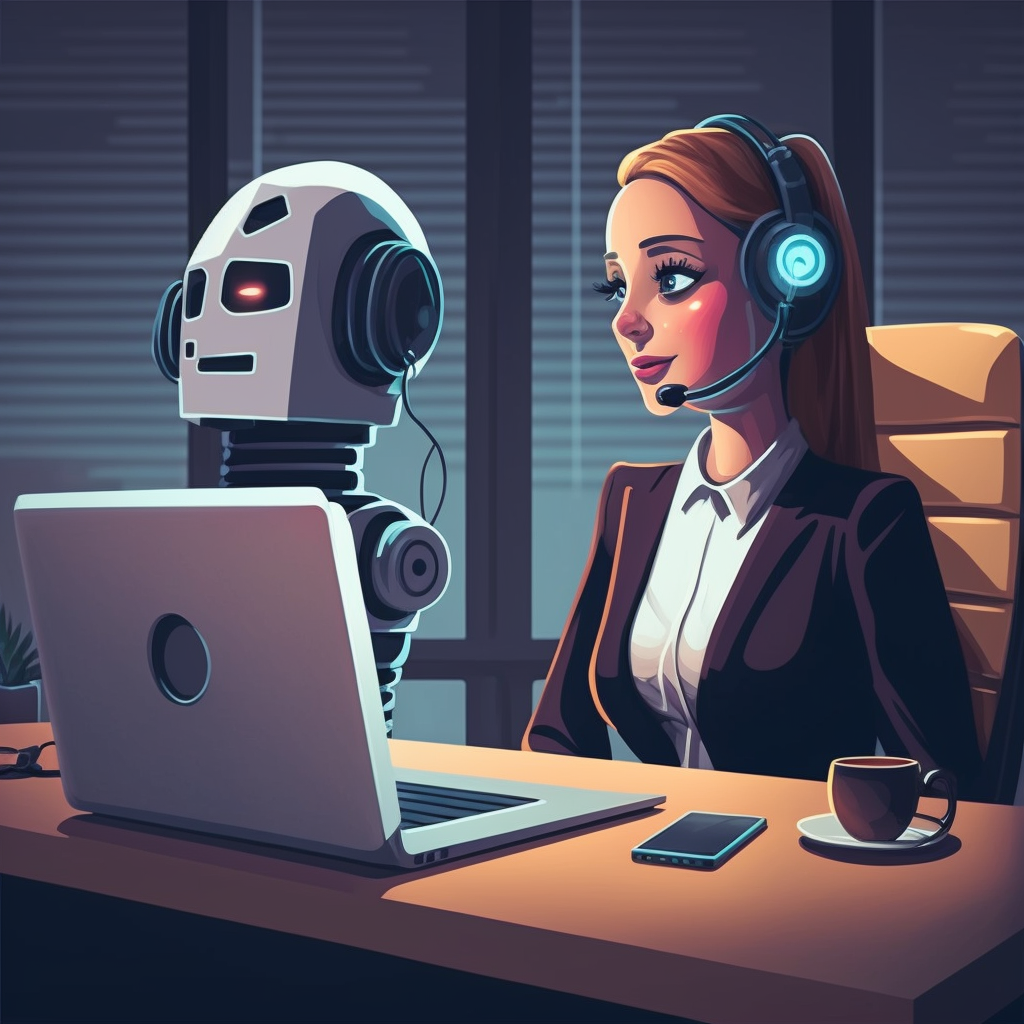The Future of Customer Interaction: Exploring the Evolution of Chatbots for CXOs
As technology evolves and customer expectations shift, the way businesses interact with their customers must also change. One technology that has gained a lot of attention in recent years is chatbots. These computer programs use artificial intelligence (AI) to simulate conversation with human users, providing automated assistance and support around the clock. In this article, we will explore the role of chatbots in customer interaction and how their evolution will impact CXOs (Chief Experience Officers) and the organizations they lead.
Understanding the Role of Chatbots in Customer Interaction
Chatbots are revolutionizing the way businesses interact with their customers. They are a logical evolution of the many customer service channels that have emerged over the years. Companies have invested heavily in creating phone, email, and chat support systems, but these solutions are often expensive to operate and maintain, leading to long wait times and frustrating experiences for customers.
Chatbots, on the other hand, can provide instant answers through natural language processing, allowing customers to get the help they need promptly, even outside of business hours. This means that customers can get the assistance they need, when they need it, without having to wait for a human representative to become available.
The Emergence of Chatbots in Customer Service

The rise of chatbots has been exponential and is likely to continue. Projections indicate that by 2021, up to 85% of customer service interactions will be handled without human involvement. This is largely due to the demand for 24/7 customer service that is cost-effective and scalable.
By eliminating the need for human support, chatbots reduce the costs associated with staffing and training customer service representatives. This means that businesses can invest more in other areas of their operations, such as product development and marketing.
Key Functions of Chatbots in Enhancing Customer Experience
There are several ways chatbots can enhance customer experience. Firstly, by providing instant answers to routine questions, customers don't have to wait in a queue or speak to a representative for simple inquiries such as account balance or product details. This can save customers time and reduce frustration, leading to a more positive overall experience.
Secondly, chatbots can help customers explore products or services in a conversational way, increasing engagement and facilitating the customer's journey through a sales funnel or a specific conversion goal. This means that customers can get the information they need in a way that feels natural and intuitive, leading to a more enjoyable experience.
Finally, when chatbots are integrated with other business systems such as CRMs, they can provide personalized recommendations and support based on a customer's purchase history or previous interactions. This means that customers can receive tailored assistance that is relevant to their specific needs, leading to a more personalized and satisfying experience.
In conclusion, chatbots are revolutionizing the way businesses interact with their customers. They provide instant and cost-effective customer service that is available 24/7, leading to a more positive overall experience for customers. By enhancing engagement, facilitating the customer's journey, and providing personalized recommendations, chatbots are becoming an essential tool for businesses looking to improve their customer experience and stay competitive in today's market.
The Evolution of Chatbot Technologies
Chatbots have come a long way since their inception and are constantly evolving to provide better customer service. With the advancements in technology, chatbots are becoming more effective and efficient in handling customer interactions. Let's take a closer look at some of the notable advancements in chatbot technologies:
Natural Language Processing and Understanding
One of the key factors that determine the success of chatbots in customer interaction is their ability to understand natural language. Natural language processing (NLP) and understanding (NLU) enable chatbots to recognize and respond to conversational cues, making interactions with customers more natural and intuitive. With NLP and NLU, chatbots can understand the intent behind a customer's inquiry and provide relevant responses, leading to a more satisfying customer experience.
For instance, if a customer types "I'm having trouble with my order," the chatbot can use NLP to understand the issue and respond with relevant troubleshooting steps. This not only saves time for the customer but also helps businesses provide faster and more efficient support.
Machine Learning and Artificial Intelligence
Machine learning (ML) has revolutionized chatbot technology, enabling them to learn from previous interactions and improve their responses. With ML, chatbots can analyze data from past interactions to identify patterns and trends, which can be used to improve their responses to similar queries in the future.
Furthermore, artificial intelligence (AI) algorithms in chatbots can help them determine the next best action, such as escalating the issue to a human representative, based on the nature of the customer's inquiry. AI-powered chatbots can also personalize interactions based on the customer's history with the brand, leading to a more engaging and personalized experience.
Integration with CRM and Other Business Systems

Chatbots can be integrated with other business systems, such as customer relationship management (CRM) and marketing automation tools, providing a more comprehensive view of the customer's journey. By integrating chatbots with these systems, businesses can gain insights into customer behavior and preferences, which can be used to improve the overall customer experience.
For example, if a customer interacts with a chatbot to resolve an issue with a product, the chatbot can update the CRM with the details of the interaction. This information can be used by the business to identify trends in customer issues and take proactive measures to address them.
In conclusion, chatbots are becoming increasingly sophisticated and are poised to revolutionize the way businesses interact with customers. With advancements in NLP and NLU, ML, and AI, chatbots are becoming more effective in providing personalized and efficient customer service. By integrating chatbots with other business systems, businesses can gain valuable insights into customer behavior and preferences, leading to a better overall customer experience.
Benefits of Implementing Chatbots for CXOs
The implementation of chatbots has many benefits for CXOs, such as:
Improved Customer Satisfaction and Engagement
Chatbots can provide personalized support and responses to customers, leading to a better customer experience overall. With increased engagement, customer satisfaction also improves, and this can drive loyalty and revenue growth.
For example, a chatbot can help customers find the products they are looking for, assist with the checkout process, and answer any questions they may have about a product or service. By providing personalized support, chatbots can help customers feel valued and understood, leading to a positive customer experience.
Cost Savings and Operational Efficiency
Chatbots can reduce the need for human support, leading to significant cost savings. Operational efficiency is also improved, as chatbots can handle multiple inquiries simultaneously, reducing wait times and frustration for customers.
For instance, a chatbot can handle routine inquiries such as password resets, order tracking, and account updates, freeing up human support staff to focus on more complex issues. This can lead to significant cost savings for businesses, as they no longer need to hire as many support staff.
Scalability and 24/7 Availability
Chatbots provide organizations with scalable and 24/7 customer support that can handle high volumes of inquiries without any human intervention. Customers can talk to chatbots at any time of day, from anywhere in the world, making businesses accessible and available beyond their traditional working hours.
For example, a chatbot can handle inquiries from customers in different time zones, ensuring that they receive support when they need it. This can help businesses expand their customer base and reach new markets, without having to worry about staffing support teams around the clock.
In conclusion, implementing chatbots can bring many benefits to CXOs, including improved customer satisfaction and engagement, cost savings, operational efficiency, scalability, and 24/7 availability. By leveraging the power of chatbots, businesses can provide better support to their customers, drive revenue growth, and stay ahead of the competition.
Challenges and Limitations of Chatbots
Implementing chatbots is not without its challenges, and organizations must be careful to ensure they provide a good experience for their customers. Some limitations include:
Choosing the Right Chatbot Platform
Chatbots are becoming increasingly popular as a way for businesses to interact with their customers. However, with this increased usage comes the risk of data breaches and privacy violations. Chatbots can inadvertently collect sensitive customer data or be hacked by malicious actors, jeopardizing the privacy and security of customers.
To prevent this, it's crucial to implement strong security protocols and ensure compliance with data protection regulations. This includes using encryption to protect sensitive data, limiting access to chatbot systems, and regularly monitoring for any suspicious activity.
Overcoming Language and Cultural Barriers
Chatbots need to be able to understand different languages and dialects to be effective in global markets. They also need to consider cultural differences and sensitivities in their responses to ensure they don't offend or confuse customers.
This can be a significant challenge, as language and cultural nuances can be difficult to program into a chatbot. However, there are solutions, such as using natural language processing (NLP) and machine learning algorithms to help chatbots understand and respond appropriately to different languages and cultures.
Managing Customer Expectations and Frustrations
Chatbots need to provide value and a good experience to customers, or they risk losing confidence and trust. Customers can get frustrated with chatbots when they don't understand their inquiries or provide irrelevant information.
To manage customer expectations and frustrations, it's essential to train chatbots to understand common customer inquiries and provide relevant responses. Chatbots can also be programmed to escalate inquiries to human agents when necessary, ensuring that customers receive the support they need.
Overall, chatbots have the potential to revolutionize customer service and provide significant benefits to businesses. However, it's crucial to be aware of the challenges and limitations associated with chatbots and take steps to address them to ensure a positive customer experience.
Best Practices for Deploying Chatbots in Your Organization
Organizations must adopt best practices when deploying chatbots to ensure they provide effective and efficient customer service. Chatbots have become a popular technology for businesses looking to improve customer service, reduce costs and increase revenue. However, deploying chatbots without a clear strategy can lead to customer frustration and lost opportunities.
Aligning Chatbot Strategy with Business Goals
Chatbots should be designed to support business objectives such as increasing revenue, reducing costs or improving customer satisfaction. Organizations should align chatbot deployment with these goals, ensuring they have a clear understanding of what the chatbot's role should be. For example, a chatbot designed to increase revenue may focus on upselling products or services, while a chatbot designed to reduce costs may focus on handling frequently asked questions.
It is important to involve key stakeholders in the development of the chatbot strategy, including customer service representatives, marketing, and IT. This ensures that the chatbot is aligned with the organization's overall goals and that it meets the needs of both customers and employees.
Selecting the Right Chatbot Platform and Technology
Choosing the right chatbot platform and technology can be a game-changer. The chatbot platform should provide the functionality required for the organization's specific use case, such as natural language processing (NLP), analytics or customer relationship management (CRM) integration. There are many chatbot platforms available, ranging from simple rule-based systems to more advanced machine learning-based systems.
Organizations should carefully evaluate the available options and select a platform that meets their specific requirements. It is also important to consider factors such as scalability, security, and ease of integration with existing systems.
Continuously Monitoring and Improving Chatbot Performance
Continuous monitoring and improvement of chatbot performance are necessary to ensure they provide accurate and satisfactory information to customers. Organizations should track metrics such as customer satisfaction, average resolution time and the number of inquiries handled by chatbots to evaluate their effectiveness.
Regular testing and optimization of the chatbot's conversational flow and NLP models can also improve its performance. It is important to involve customer service representatives in the monitoring and improvement process, as they can provide valuable insights into customer needs and pain points.
In conclusion, deploying a chatbot can be a valuable addition to an organization's customer service strategy, but it is important to adopt best practices to ensure its success. By aligning the chatbot strategy with business goals, selecting the right platform and technology, and continuously monitoring and improving performance, organizations can provide effective and efficient customer service through chatbots.
The Future of Chatbots and Customer Interaction
As chatbots continue to evolve, new advancements will shape the future of customer interaction. Here are some of the latest trends and technologies:
Advanced Personalization and Predictive Analytics
Chatbots are already providing personalized experiences by leveraging data from other sources such as social media, browsing history and purchase behavior. However, with the help of predictive analytics, chatbots will be able to anticipate customer needs and provide proactive support. For example, if a customer frequently orders a certain product, the chatbot can suggest related products or promotions that the customer may be interested in.
Furthermore, chatbots will also be able to personalize their tone and language based on the customer's preferences and personality. This will create a more natural and engaging conversation, leading to higher customer satisfaction.
Voice-Activated and Multimodal Chatbots
With the rise of smart speakers and voice assistants, voice-activated chatbots will become more prevalent. Customers will be able to interact with chatbots through natural language processing, making the conversation more intuitive and seamless.
In addition, multimodal chatbots that can interact via chat or voice will provide customers with even more flexibility and convenience. For example, a customer can start a conversation with a chatbot on their phone and continue the conversation through their smart speaker when they get home.
The Role of Human-AI Collaboration in Customer Service
As chatbots become more sophisticated, their role in customer service will shift from handling routine inquiries to providing more complex support. This will also create opportunities for human-AI collaboration, where chatbots can escalate to human representatives when a more personal touch is required.
For example, if a customer is experiencing a technical issue that the chatbot cannot resolve, the chatbot can seamlessly transfer the conversation to a human representative who has access to the customer's chat history and can provide more personalized support.
Overall, the future of chatbots and customer interaction is exciting and full of possibilities. With the help of advanced personalization, voice-activated and multimodal capabilities, and human-AI collaboration, chatbots will continue to enhance the customer experience and revolutionize the way we interact with businesses.
Conclusion
Chatbots are an exciting addition to the world of customer interaction, providing organizations with scalable, cost-effective and personalized support. The key challenge for CXOs and their organizations is to ensure they integrate chatbots seamlessly into their overall customer experience strategy while mitigating the risks involved. With careful planning, deployment and ongoing optimization, chatbots can offer a bright future for businesses and their customers alike.

